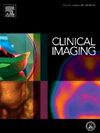A model for prediction of recurrence of non-small cell lung cancer based on clinical data and CT imaging characteristics
IF 1.8
4区 医学
Q3 RADIOLOGY, NUCLEAR MEDICINE & MEDICAL IMAGING
引用次数: 0
Abstract
Objectives
To establish a model for prediction of recurrence of non-small cell lung cancer (NSCLC) based on clinical data and computed tomography (CT) imaging characteristics.
Methods
A total of 695 patients with surgically resected NSCLC confirmed by pathology at three centers were retrospectively investigated. 626 patients from center 1 were randomly divided into two sets in a ratio of 7:3 (training set, n = 438; testing set, n = 188), 69 patients from center 2 and 3 were assigned in the external validation set. Univariate and binary logistic regression analyses of clinical and CT imaging features determined the independent risk factors used to construct the model. The receiver-operating characteristic curve nomogram and decision curves analysis were used to evaluate the predictive ability of the model.
Results
The mean patient age was 63.3 ± 10.1 years, and 44.7 % (311/695) were male. The univariate and binary logistic regression analyses identified four independent risk factors (age, tumor markers, consolidation/tumor ratio, and pleural effusion), which were used to construct the prediction model. In the training set, the model had an area under the curve of 0.857, an accuracy of 71.7 %, a sensitivity of 88.1 %, and a specificity of 70.0 %; in the testing set, the respective values were 0.867, 75.5 %, 94.4 %, and 73.5 %; in the external validation set, the respective values were 0.852, 79.7 %, 83.3 %, 78.9 %.
Conclusion
A prediction model based on clinical data and CT imaging characteristics showed excellent efficiency in prediction of recurrence of NSCLC. Clinical use of this model could be useful for selection of appropriate treatment options.
求助全文
约1分钟内获得全文
求助全文
来源期刊

Clinical Imaging
医学-核医学
CiteScore
4.60
自引率
0.00%
发文量
265
审稿时长
35 days
期刊介绍:
The mission of Clinical Imaging is to publish, in a timely manner, the very best radiology research from the United States and around the world with special attention to the impact of medical imaging on patient care. The journal''s publications cover all imaging modalities, radiology issues related to patients, policy and practice improvements, and clinically-oriented imaging physics and informatics. The journal is a valuable resource for practicing radiologists, radiologists-in-training and other clinicians with an interest in imaging. Papers are carefully peer-reviewed and selected by our experienced subject editors who are leading experts spanning the range of imaging sub-specialties, which include:
-Body Imaging-
Breast Imaging-
Cardiothoracic Imaging-
Imaging Physics and Informatics-
Molecular Imaging and Nuclear Medicine-
Musculoskeletal and Emergency Imaging-
Neuroradiology-
Practice, Policy & Education-
Pediatric Imaging-
Vascular and Interventional Radiology
 求助内容:
求助内容: 应助结果提醒方式:
应助结果提醒方式:


